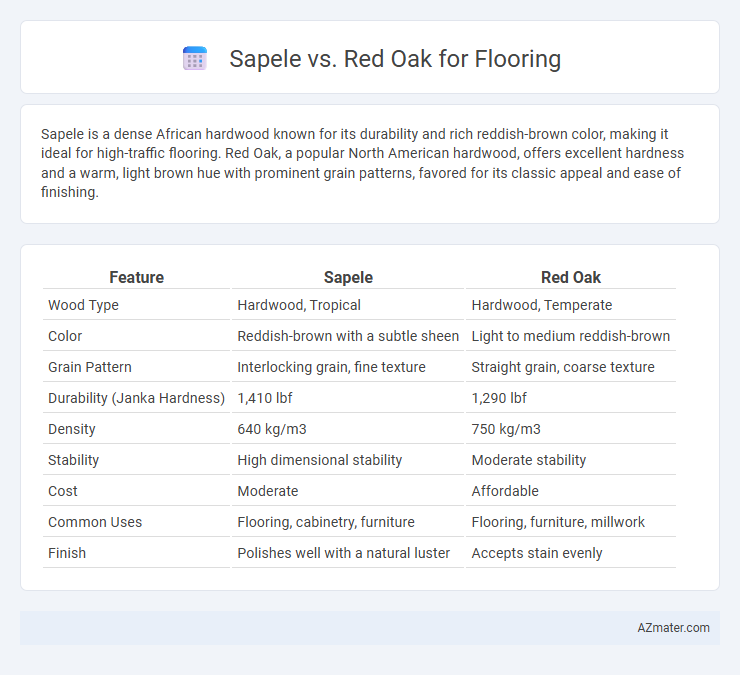Sapele is a dense African hardwood known for its durability and rich reddish-brown color, making it ideal for high-traffic flooring. Red Oak, a popular North American hardwood, offers excellent hardness and a warm, light brown hue with prominent grain patterns, favored for its classic appeal and ease of finishing.
Table of Comparison
| Feature | Sapele | Red Oak |
|---|---|---|
| Wood Type | Hardwood, Tropical | Hardwood, Temperate |
| Color | Reddish-brown with a subtle sheen | Light to medium reddish-brown |
| Grain Pattern | Interlocking grain, fine texture | Straight grain, coarse texture |
| Durability (Janka Hardness) | 1,410 lbf | 1,290 lbf |
| Density | 640 kg/m3 | 750 kg/m3 |
| Stability | High dimensional stability | Moderate stability |
| Cost | Moderate | Affordable |
| Common Uses | Flooring, cabinetry, furniture | Flooring, furniture, millwork |
| Finish | Polishes well with a natural luster | Accepts stain evenly |
Introduction to Sapele and Red Oak Flooring
Sapele flooring offers a rich, reddish-brown color with a fine, interlocking grain that provides both durability and an elegant appearance, making it ideal for high-traffic areas. Red Oak flooring is prized for its classic, light to medium reddish hues and prominent grain patterns, offering strong hardness and a timeless aesthetic favored in traditional and modern interiors. Both woods provide excellent hardness ratings on the Janka scale, with Sapele around 1,410 and Red Oak at approximately 1,290, ensuring long-lasting performance and wear resistance.
Appearance and Grain Patterns
Sapele flooring features a rich, reddish-brown hue with a natural luster that darkens over time, providing a luxurious and warm aesthetic. Its interlocking grain pattern creates a striking ribbon stripe effect, adding depth and visual interest to floors. In contrast, Red Oak offers a lighter, more neutral tan to reddish color with a pronounced, straight grain and occasional wavy patterns, making it versatile for various interior designs.
Color Variations and Aging
Sapele flooring features rich reddish-brown hues with a subtle, shimmering grain that deepens to a warm mahogany tone as it ages, enhancing its elegance. Red Oak offers a more varied palette ranging from light pinkish-brown to deeper reddish tones, developing a richer patina and mellowing into golden-brown shades over time. Both woods exhibit distinct color transformations with aging, but Sapele maintains a more uniform chromatic depth while Red Oak provides greater natural variation and character.
Durability and Hardness Comparison
Sapele wood offers a hardness rating of approximately 1,410 on the Janka scale, making it moderately durable for flooring, while Red Oak scores around 1,290, indicating slightly less hardness. Both woods provide good wear resistance, but Sapele's higher density enhances its durability in high-traffic areas. Red Oak's widespread availability and resilience make it a cost-effective choice, though Sapele's dimensional stability and resistance to denting offer superior longevity.
Installation Considerations
Sapele flooring requires precise acclimation due to its tropical hardwood nature, typically needing 7-14 days to adjust to indoor humidity before installation. Red Oak, a domestic wood, offers easier installation with better dimensional stability in varied climates, reducing expansion and contraction risks. Both species demand proper subfloor preparation and moisture testing to ensure a smooth, long-lasting finish.
Maintenance and Care Requirements
Sapele flooring requires moderate maintenance, needing regular sweeping and occasional damp mopping to prevent dirt buildup and maintain its rich appearance. Red Oak flooring demands frequent cleaning due to its porous nature, with routine dusting and prompt spill cleanup to avoid staining. Both hardwood options benefit from periodic refinishing to protect against wear, but Red Oak typically requires more frequent attention to preserve its finish over time.
Cost Differences and Value
Sapele flooring typically costs between $4 to $7 per square foot, making it a more affordable alternative compared to Red Oak, which ranges from $5 to $10 per square foot depending on grade and finish. Despite its lower price, Sapele offers exceptional durability and a rich reddish-brown color that adds significant aesthetic value, while Red Oak delivers a classic appeal with a lighter tone and pronounced grain patterns favored in traditional designs. Choosing between Sapele and Red Oak for flooring depends on budget constraints and desired visual impact, with Red Oak potentially offering higher resale value in markets valuing traditional hardwoods.
Environmental Impact and Sustainability
Sapele, a tropical hardwood sourced primarily from West Africa, offers greater environmental sustainability compared to Red Oak due to its rapid growth rate and availability from responsibly managed forests, reducing deforestation risks. Red Oak, native to North America, is widely harvested but often associated with slower growth and higher demand, which can lead to increased ecological strain. Choosing Sapele for flooring supports reduced carbon footprint and promotes biodiversity by encouraging the use of certified sustainable timber.
Suitability for Different Interior Styles
Sapele flooring features a deep reddish-brown hue with fine grain patterns, making it ideal for traditional, rustic, or colonial interior styles that emphasize warmth and character. Red Oak offers a lighter, more neutral tone with pronounced grain variation, complementing contemporary, modern, and Scandinavian designs by providing a bright and versatile foundation. Both hardwoods deliver durability, but choosing between Sapele and Red Oak depends on whether the interior style favors rich, classic elegance or clean, minimalist aesthetics.
Which Wood is Best for Your Flooring Needs?
Sapele offers a rich, reddish-brown hue with a fine, interlocking grain, providing durability and resistance to wear, ideal for high-traffic areas. Red Oak boasts a lighter tone with prominent grain patterns, known for its hardness and versatility, making it suitable for various interior styles. Choosing between Sapele and Red Oak depends on your preference for color depth, grain aesthetics, and the level of durability required for your flooring needs.

Infographic: Sapele vs Red Oak for Flooring
 azmater.com
azmater.com